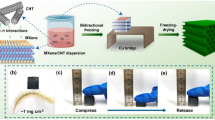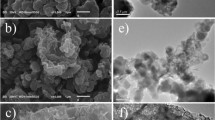Abstract
Nanocomposites consisting of the conducting polymer, polyaniline (PANI), and multiwalled carbon nanotubes (MWNT) were prepared by in situ emulsion polymerization of aniline monomer on the surface of MWNT, using sodium dodecyl sulfate as an emulsifier and by varying the wt% of the MWNT. The morphology, composition, and thermal stability of the PANI-MWNT nanocomposites and pure PANI were characterized by Fourier transform infrared spectroscopy (FT-IR), X-ray diffraction (XRD), thermogravimetric analysis (TGA), and field emission electron microscopy (FE-SEM). The PANI-MWNT nanocomposites were found to be crystalline in nature, with the PANI corals grown uniformly on the MWNT. Symmetric supercapacitors were constructed using the PANI-MWNT nanocomposites and pure PANI. Electrochemical analysis of the nanocomposites was performed using cyclic voltammetry and the galvanostatic charge-discharge method. The cyclic voltammetry analysis showed a synergistic increase in the specific capacitance of the PANI-MWNT nanocomposites. The unique structure of the PANI-MWNT nanocomposites led to a high specific capacitance of 240 F g−1 at a current density of 4.0 A g−1, with good rate performance, and 93 % retention of specific capacitance after 5000 CD cycles, indicating their potential as an electrode material for supercapacitors.










Similar content being viewed by others
References
Simon P, Gogotsi Y (2008) Materials for electrochemical capacitors. Nat Mater 7:845–854
Ferreira HL, Garde R, Fulli G, et al. (2013) Characterisation of electrical energy storage technologies. Energy 53:288–298
Lee SY, JIL K, SJ P (2014) Activated carbon nanotubes/polyaniline composites as supercapacitor electrodes. Energy 78:298–303
Wei W, Cui X, Chen W, Ivey DG (2011) Manganese oxide-based materials as electrochemical supercapacitor electrodes. Chem Soc Rev 40:1697–1721
Yang Y, Hao Y, Yuan J, et al. (2014) In situ preparation of caterpillar-like polyaniline/carbon nanotube hybrids with core shell structure for high performance supercapacitors. Carbon N Y 78:279–287
Pan H, Li J, Feng YP (2010) Carbon nanotubes for supercapacitor. Nanoscale Res Lett 5:654–668
Potphode DD, Sivaraman P, Mishra SP, Patri M (2015) Polyaniline/partially exfoliated multi-walled carbon nanotubes based nanocomposites for supercapacitors. Electrochim Acta 155:402–410
Khomenko V, Frackowiak E, Béguin F (2005) Determination of the specific capacitance of conducting polymer/nanotubes composite electrodes using different cell configurations. Electrochim Acta 50:2499–2506
Mittal G, Dhand V, Rhee KY, et al. (2015) A review on carbon nanotubes and graphene as fillers in reinforced polymer nanocomposites. J Ind Eng Chem 21:11–25
Guo F, Mi H, Zhou J, et al. (2015) Hybrid pseudocapacitor materials from polyaniline@multi-walled carbon nanotube with ultrafine nanofiber-assembled network shell. Carbon 95:323–329
Otrokhov G, Pankratov D, Shumakovich G, et al. (2014) Enzymatic synthesis of polyaniline/multi-walled carbon nanotube composite with core shell structure and its electrochemical characterization for supercapacitor application. Electrochim Acta 123:151–157
Bhandari S, Khastgir D (2015) Synergistic effect of simultaneous dual doping in solvent-free mechanochemical synthesis of polyaniline supercapacitor comparable to the composites with multiwalled carbon nanotube. Polym (United Kingdom) 81:62–69
Wu W, Li Y, Yang L, et al. (2014) Preparation and characterization of coaxial multiwalled carbon nanotubes/polyaniline tubular nanocomposites for electrochemical energy storage in the presence of sodium alginate. Synth Met 193:48–57
Wu M, Snook GA, Gupta V, et al. (2005) Electrochemical fabrication and capacitance of composite films of carbon nanotubes and polyaniline. J Mater Chem 15:2297–2303
Mi H, Zhang X, An S, et al. (2007) Microwave-assisted synthesis and electrochemical capacitance of polyaniline/multi-wall carbon nanotubes composite. Electrochem Commun 9:2859–2862
Sivakkumar SR, Kim WJ, Choi JA, et al. (2007) Electrochemical performance of polyaniline nanofibres and polyaniline/multi-walled carbon nanotube composite as an electrode material for aqueous redox supercapacitors. J Power Sources 171:1062–1068
Zhang J, Kong L-B, Wang B, et al. (2009) In-situ electrochemical polymerization of multi-walled carbon nanotube/polyaniline composite films for electrochemical supercapacitors. Synth Met 159:260–266
Zhu ZZ, Wang GC, Sun MQ, et al. (2011) Fabrication and electrochemical characterization of polyaniline nanorods modified with sulfonated carbon nanotubes for supercapacitor applications. Electrochim Acta 56:1366–1372
Zhou Y, Qin ZY, Li L, et al. (2010) Polyaniline/multi-walled carbon nanotube composites with core-shell structures as supercapacitor electrode materials. Electrochim Acta 55:3904–3908
Bavio MA, Acosta GG, Kessler T (2014) Synthesis and characterization of polyaniline and polyaniline—carbon nanotubes nanostructures for electrochemical supercapacitors. J Power Sources 245:475–481
Fathi M, Saghafi M, Mahboubi F, Mohajerzadeh S (2014) Synthesis and electrochemical investigation of polyaniline/unzipped carbon nanotube composites as electrode material in supercapacitors. Synth Met 198:345–356
Zheng L, Wang X, An H, et al. (2011) The preparation and performance of flocculent polyaniline/carbon nanotubes composite electrode material for supercapacitors. J Solid State Electrochem 15:675–681
Li F, Shi J, Qin X (2010) Synthesis and supercapacitor characteristics of PANI/CNTs composites. Chin Sci Bull 55:1100–1106
Kong LB, Zhang J, An JJ, et al (2008) MWNTs/PANI composite materials prepared by in-situ chemical oxidative polymerization for supercapacitor electrode. In: J Mater Sci pp 3664–3669
Gao B, Fu Q, Su L, et al. (2010) Preparation and electrochemical properties of polyaniline doped with benzenesulfonic functionalized multi-walled carbon nanotubes. Electrochim Acta 55:2311–2318
Bal Sydulu S, Palaniappan S, Srinivas P (2013) Nano fibre polyaniline containing long chain and small molecule dopants and carbon composites for supercapacitor. Electrochim Acta 95:251–259
Deshmukh PR, Shinde NM, Patil SV, et al. (2013) Supercapacitive behavior of polyaniline thin films deposited on fluorine doped tin oxide (FTO) substrates by microwave-assisted chemical route. Chem Eng J 223:572–577
Sydulu Singu B, Srinivasan P, Pabba S (2012) Benzoyl peroxide oxidation route to nano form polyaniline salt containing dual dopants for pseudocapacitor. J Electrochem Soc 159:A6–A13
Dhibar S, Bhattacharya P, Hatui G, et al. (2014) Transition metal-doped polyaniline/single-walled carbon nanotubes nanocomposites: efficient electrode material for high performance supercapacitors. ACS Sustain Chem Eng 2:1114–1127
Xiong S, Yuan C, Zhang X, et al. (2009) Controllable synthesis of mesoporous Co3O4 nanostructures with tunable morphology for application in supercapacitors. Chem - A Eur J 15:5320–5326
Park JC, Kim J, Kwon H, Song H (2009) Gram-scale synthesis of Cu2O nanocubes and subsequent oxidation to CuO hollow nanostructures for lithium-ion battery anode materials. Adv Mater 21:803–807
Xia X, Tu J, Wang X, et al. (2011) Hierarchically porous NiO film grown by chemical bath deposition via a colloidal crystal template as an electrochemical pseudocapacitor material. J Mater Chem 21:671–679
Yuan C, Chen L, Gao B, et al. (2009) Synthesis and utilization of RuO 2 ·xH 2 O nanodots well dispersed on poly(sodium 4-styrene sulfonate) functionalized multi-walled carbon nanotubes for supercapacitors. J Mater Chem 19:246–252
Choi BG, Yang M, Hong WH, et al. (2012) 3D macroporous graphene frameworks for supercapacitors with high energy and power densities. ACS Nano 6:4020–4028
Yang C, Zhou M, Xu Q, et al. (2013) Three-dimensional ordered macroporous MnO2/carbon nanocomposites as high-performance electrodes for asymmetric supercapacitors. Phys Chem Chem Phys 15:19730–19740
Zhu YG, Wang Y, Shi Y, et al. (2014) CoO nanoflowers woven by CNT network for high energy density flexible micro-supercapacitor. Nano Energy 3:46–54
Palmas S, Mascia M, Vacca A, et al. (2014) Analysis of photocurrent and capacitance of TiO2 nanotube–polyaniline hybrid composites synthesized through electroreduction of an aryldiazonium salt. RSC Adv 4:23957–23965
Acknowledgments
Encouragement for this research work by the Council of Scientific and Industrial Research under the Solar Mission Project is gratefully acknowledged. Author SBS thanks UGC, New Delhi, for research fellowship.
Author information
Authors and Affiliations
Corresponding author
Electronic supplementary material
Fig. S
(DOCX 46 kb)
Rights and permissions
About this article
Cite this article
Sydulu Singu, B., Srinivasan, P. & Yoon, K.R. Emulsion polymerization method for polyaniline-multiwalled carbon nanotube nanocomposites as supercapacitor materials. J Solid State Electrochem 20, 3447–3457 (2016). https://doi.org/10.1007/s10008-016-3309-1
Received:
Revised:
Accepted:
Published:
Issue Date:
DOI: https://doi.org/10.1007/s10008-016-3309-1




